
Origins of the Digital Age (Part 1: Mechanical Clocks, Electricity, and Radio) – A Timeline
March 5, 2024
Future of the Digital Age (Part 3: Robotics, Quantum Computing, and the Rise of Artificial Intelligence) – A Timeline
April 3, 2024History of the Digital Age (Part 2: The Transistor, Microchips, and the Dawn of the Internet) – A Timeline

Last time, in Part One (Mechanical Clocks, Electricity, and Radio), we talked about the Abacus, the Chinese ‘Cosmic Engine’, the mysterious Antikythera mechanism, robots in early Science Fiction, Charles Babbage, Ada Lovelace, Edison, Tesla, Alan Turing, and all the incredible inventions that paved the way for the creation of the world’s first computer…

1938-1941
The Z3 – the first digital programmable Electro-Mechanical Computer! – created by a dude named Konrad Zuse.

1939
One of the earliest (electric-powered) Robots: “Elektro” is unveiled by Westinghouse at the 1939 New York World’s Fair!
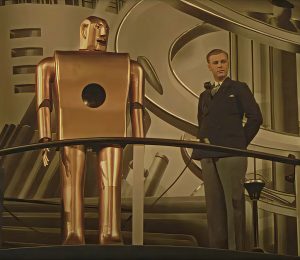
1941
Hedy Lamarr the gorgeous Austrian-born, Hollywood actress, helps to invent “Frequency Hopping” for the US Navy during WWII to counteract radar-jamming. This eventually becomes the basis for GPS, Wi-Fi, and Bluetooth!

1942
Legendary sci-fi author, Isaac Asimov devises the “Three Laws of Robotics” in his short story, “Runaround” (later collected in “I, Robot” in 1950).

1944
The Colossus Mark I – the world’s first fully electronic digital computer – using vacuum tubes! This truly was a colossal piece of machinery – basically the equivalent of a warehouse-sized pocket calculator! It was used by the US military during WWII to further help crack the German Enigma codes, following Alan Turing’s work.
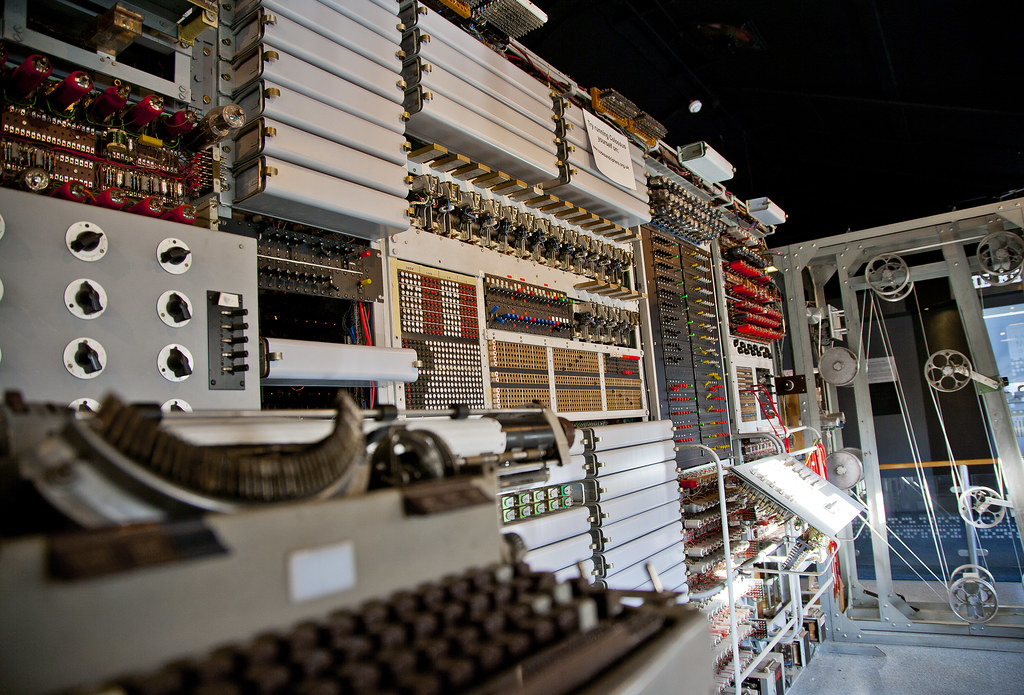
1944
The IBM Harvard Mark 1 is conceived of by Professor Howard Aiken – a room-sized, relay-based calculator! The complex machine had an astounding 3,500 relays, with a fifty-foot-long camshaft!

1945
The first electric, programable, digital computer: ENIAC (Electronic Numerical Integrator and Compute) is first developed for the US Army’s R and D department, as directed by Major General Gladeon M. Barnes.

The Eniac machines were operated by plugging and unplugging cables, and slipping switches!
1946-1954
The creation of the Color Television set was a process that took place over several years form 1946 to 1954 – pioneered by RCA and CBS, based on the earlier work of John Logie Baird. Although Color TV didn’t quite go mainstream until 1965 for various technical and economical reasons.
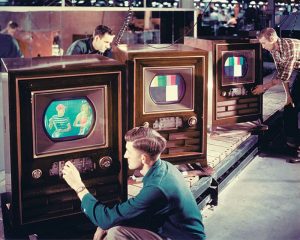
1947
The First Transistor is created by three scientists (William Shockley, John Bardeen, and Walter Brattain) at Bell Laboratories in New Jersey, for AT&T on December 16th, 1947. A simple device consisting of a germanium semiconductor, a spring, and gold foil contacts. The invention of the point-contact transistor revolutionized the entire electronics industry overnight, making modern digital computer technologies possible, forever changing the world…

William Shockley foresaw potential in silicon diodes, and is known today as “the father of Silicon Valley”.
1949
George Orwell’s “1984” – a dystopian novel that many consider to be a prophetic warning about totalitarian government surveillance, with concepts like “Big Brother” and “The Thought Police”.
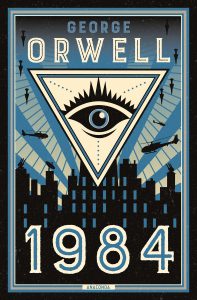
1951
The first Artificial Neural Network (ANN) is developed by Marvin Minsky and Dean Edmonds. It takes 3,000 vacuum tubes to simulate 40 neurons!
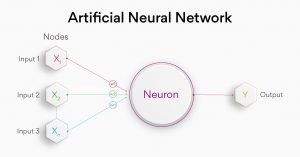
1952
UNIVAC – The Remington-Rand ‘Universal Automatic Computer’ correctly predicts the results of the 1952 Presidential election! (Spoilers: Eisenhower won. So I guess you could say, the computer liked Ike?)
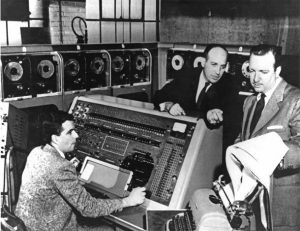
1952
Arthur Samuel codes the first checkers-playing-program. Samuel later coined the term “Machine Learning” in 1959.

1953
Another vintage robot, “Sparks” (El Chispas) is built in Spain by Antoni Gual Segura and his colleagues at a local radio station.
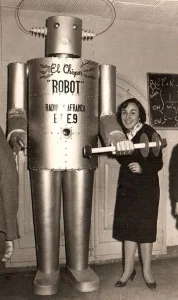
1954
Unimate – the first Autonomous Industrial Robot (aka the ‘programmable transfer machine’) is patented by George Devol. After being developed in 1961, it’s employed by a General Motors assembly plant in New Jersey, and quickly transformed the automotive industry over night.

1955
The first (accurate) Atomic Clock is invented by Louis Essen in the UK.

1956
Allen Newell, Cliff Shaw, and Herbert Simon created a complex mathematical program, funded by the RAND Corporation, called “Logic Theorist” that could outperform human calculations, considered one of the first steps towards modern A.I. John McCarthy coins the phrase “Artificial Intelligence” at a Dartmouth academic workshop.

1957
The first production Disk Drive, the IBM RAMAC 350: just 3.75 megabytes!

1957: 3.75 MB
1957
The USSR launches the first (man-made) satellite Sputnik-1 into orbit, igniting the Space Race between the US and Soviet Union.

1958
President Dwight D. Eisenhower authorized the creation of DARPA – the Defense Advanced Research Projects Agency (originally just ARPA) in response to the Soviets’ rapid success with their space program and nuclear capability, along with the non-military research initiative: NASA – the National Aeronautics and Space Administration that same year!

1958
The first video game – “Tennis for Two” (an early version of “Pong”) is invented by William Higinbotham (one of the scientists who developed the Atomic Bomb during The Manhattan Project) using a Donner Model 30 Analog Computer and an Oscilloscope – as a side project! This was followed closely by “Spacewar!” in 1962, developed by a group of students at MIT.

^ SPACEWAR!
1959
Jack Kilby creates the first Integrated Circuit! This was such a profound leap forward in computer technology that it’s hard to even explain what a huge deal this was. His innovation paved the way for smaller, more powerful computers. This started a trend of progressively smaller and more powerful microchip processors, which also made the technology more versatile and affordable, and it lead to an exponential growth in computer technology that continues to this day! Kilby was awarded the Nobel Prize in physics in 2000 for his contribution to creating the world’s first “micro-chip”!

1959
The IBM-7090 is developed. This vacuum-tube-powered mainframe was used during the early days of NASA with the Mercury and Gemini missions. (Later replaced by IBM’s System 360 during Apollo.)

1960
One of the earliest experiments in free-roaming autonomous robotics, “The Stanford Cart” is first designed and constructed by a Mechanical Engineering graduate, James L. Adams!
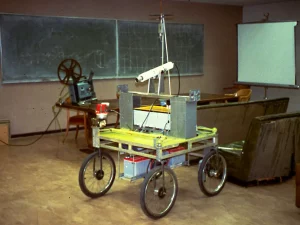
1960
The world’s first LASER!

“Pew pew!”
Built at Hughes Research Laboratory by Theodore Maiman, based on the concepts that Charles H. Townes first proposed. Lasers are basically intense beams of monochromatic light / electromagnetic radiation resulting from excited molecules that emit a focused stream of photons. Laser technology made the earliest rudimentary holograms possible in 1962. Today, lasers are used for bar code scanners, military guidance systems, laser-eye surgery, industrial cutting, and even medical surgery! Also, more importantly: laser light shows and techno raves.

Techno Music Intensifies
1961
Hughes Aircraft Electronic Labs unveiled the Magnificent Mobile Robot: “Mobot”!

1962
Nick Holonyak inadvertently creates the first LED light when experimenting with lasers (see above), for GE.
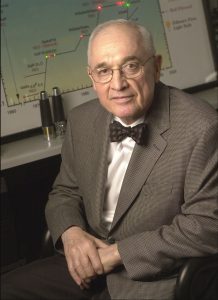
1962
Ivan Sutherland, an MIT graduate, develops one of the first optical touchscreen devices, with a stylus, for AT&T. This was also one of the earliest developments in Vector Graphics!

Vector Graphics (unlike regular pixel art) use mathematical calculations to create diagonal lines and shapes. Some of the earliest “3D” arcade video games used Vector Graphics in the late 70’s to give the illusion of depth. Vector Graphics are still employed in print media today, in creating billboards, because vector images can be scaled up without a loss of quality, with the help of programs like Adobe Illustrator.
1962
The US launches “Telstar 1” into orbit – the first communications satellite!

1965
Gordon E. Moore, the co-founder of Intel creates “Moore’s Law” which states that: “The Number of Transistors on a microchip doubles every two years, though the cost of computers is halved. And the growth of microprocessors is exponential.” He was right.
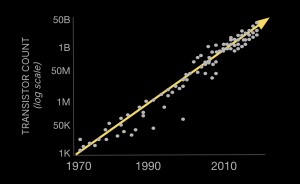
1965
Edward Feigenbaum, a Stanford Programmer, creates the first “Expert Systems” using If/Then algorithms to mimic the human decision-making process.
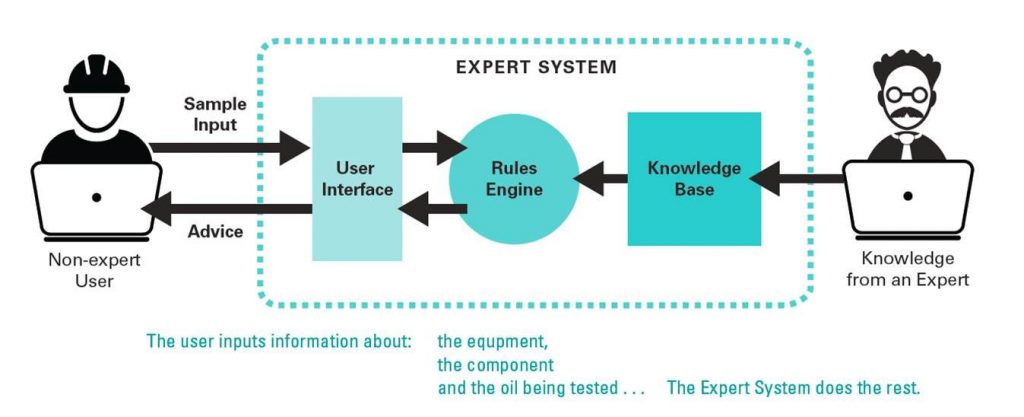
1965
The first *finger operated* touchscreen is invented in England, by Radar specialist, Eric Johnson. Over 50 years before the first Smart Phone!

1965
Fiber-Optics are used in data transmission for the first time by German physicist, Manfred Börner. NASA began using Fiber-Optics systems and cameras in 1968, during the Apollo missions to the moon, but it was classified technology at the time.

1965
“DUNE” by Frank Herbert – takes place thousands of years in the future, in an interstellar society that has essentially banned computers, because of an AI uprising in the distant past… (Click here for my review of the 2021 movie adaptation!)

1966
The first “AI” chatbot, “ELIZA” is created.

1966
Stanford Research Institute (SRI) creates the first fully mobile intelligent robot: “Shakey”. The predecessor to both drones and self-driving vehicles…

1966
The United States begins funding the development of Flight Simulators for NASA, using 3D computer image generation, later used by the Air Force to help train pilots – a big first step towards Virtual Reality.

1968
“Do Androids Dream of Electric Sheep?” by Philip K. Dick. The story is all about the philosophical questions regarding what it means to be man or machine. The book later inspired Ridley Scott’s “Blade Runner” starring Harrison Ford in 1982. (Click here for my Podcasters Disassembled episode!)

1968
Douglas Engelbart demonstrates the first GUI (Graphical User Interface) with a wooden, makeshift “mouse” as its controller.

The first computer ‘mouse’!
1968
“2001: A Space Odyssey” – Directed by Stanley Kubrick, based on the novel by Arthur C. Clarke. The movie features ‘HAL 9000’ an evil AI that hijacks a mission to Jupiter and attempts to kill the crew…

“Good morning Dave.”
1969
DARPA – creates the ARPAnet – the precursor to THE INTERNET! The inspiration for the system was first proposed in 1960. On October 29, 1969 the first link happened between UCLA and the Stanford Research Institute (SRI).

Leonard Kleinrock, one of the head researchers of the project, said in an interview: “We typed the L and we asked on the phone, ‘Do you see the L?’ ‘Yes, we see the L,’ came the response.
We typed the O, and we asked, ‘Do you see the O?’ ‘Yes, we see the O.’
Then we typed the G, and the system crashed … Yet a revolution had begun.”

Over the next few decades, from the late 50’s through the late 70’s, DARPA scientists made incredible leaps in technology, throwing caution to the wind and prioritizing advancement over peer reviewed studies. During this time they created an early version of the internet known as ARPA-NET, which was interconnected network between the Department of Defense’s primary computers from NORAD HQ in Cheyenne Mountain to the Pentagon in DC.
They were also tasked with investigating the viability of Artificial Intelligence, and saw the potential in creating a machine that could transcribe and translate spoken language, which at the time was mere science fiction, but it’s something everyone now takes for granted.
1969
Bell Labs invents the UNIX Operating System (OS) utilizing the C Programming Language.

“Hello World”
1969
NASA Astronauts, Buzz Aldrin and Neil Armstrong become the first men to walk on the moon, during Apollo 11. The “Eagle” Lunar Lander was equipped with an onboard guidance system, The AGC (Apollo Guidance Computer) – the first computer built entirely on Silicon Integrated Circuits!

This 70-pound computer had less than *80 kilobytes* of memory, and took about the same amount of watts to power a light bulb! To put things into perspective: 1 measly Megabyte is 1,024 kilobytes, and a single high-res photo is just 3.5 MB!
1970
Intel creates the first Dynamic Random Access Memory chip (D-RAM)

1971
IBM invents the “Floppy Disc”, and Disc-Drive.
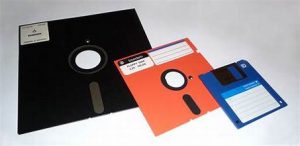
1972
NASA decides to use the IBM AP-101 as the onboard computer for the Space Shuttle!

1973
Xerox develops Ethernet (to connect computers and hardware on a network).
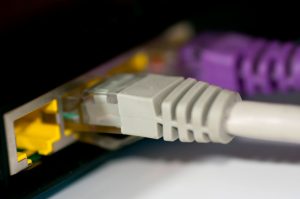
1973
The first Cell Phone (Cellular Phone) developed by Martin Cooper for Motorola.

1973
GPS (Global-Positioning-System) is created by the US Department of Defense – a satellite-based radio navigation system used to relay one’s exact position anywhere on the globe.

1973
Japanese robotics really took off in the 1970’s with the WABOT-1 (followed later by a second, far more advanced model in 1980!)
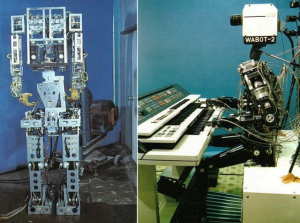
1974
The First Home Computer, MITS Altair 8800.

1975
The first Digital Camera is created by Steven Sasson, while working for Kodak. The original model was 8 pounds! Although, due to the price and technical limitations, digital cameras didn’t start to catch on until the late 1980’s.
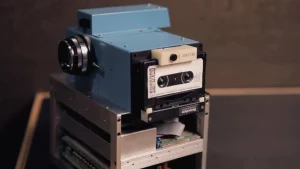
1975
After a series of failed Soviet probes, the robotic Russian Venera-9 spacecraft transmits the first image from the surface of Venus back to Earth, lasting for just 53 minutes before succumbing to the harsh environment of the planet…


1975
Bill Gates and Paul Allen, two geeks who taught themselves coding with BASIC, found their own company: Microsoft.

1976
Steve Jobs and Steve Wozniak co-found Apple, from their garage! Eventually unveiling their first computer: The Apple I. It was the first personal computer with a single circuit board and ROM!

1976
The JVC company debuts the VHS video tape and VCR player in Japan, revolutionizing media for the next couple decades.

1977
One of the most prominent early home video game consoles, the Atari 2600 makes its debut.

Classic Atari games include: “Asteroids” (1979), “Adventure” (1980), “Frogger” (1981), and “Pitfall” (1982).
1977
The TSR-80 PC’s hit the market!

1977
The Apple II is unveiled, complete with an audio cassette drive and color graphics!
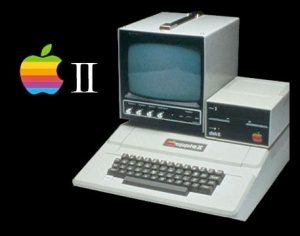
1977
“Star Wars” – Directed by George Lucas, features some of the earliest computer graphics in a movie, with the archaic Atari-like computer simulation of the Rebel’s attack plan on the Death Star!

The movie also features a pair of famous droids, R2-D2 and C-3P0…

And of course ‘Star Wars’ also introduces one of the greatest cinematic villains of all time: Darth Vader – a cybernetic Sith Lord and enforcer of the Galactic Empire! As the Jedi Knight Obi-Wan Kenobi says, “He’s more machine now than man, twisted and evil…”

1977
The two Voyager probes are launched into space by NASA (with some help from Carl Sagan) to study and photograph the planets of our solar system, eventually becoming the first (and so far – only) man-made objects to actually leave the solar system! These twin interstellar probes each had 3 CPU’s on board: flight control systems, orientation mechanisms, and scientific sensors – each with less computing power than a Commodore 64!

Voyager 1 officially left our Solar System in 2012, followed soon after by its sister, Voyager 2, in 2018! The really amazing thing however is that those onboard computers are still operating to this day in 2024!
1978
The first spreadsheet software is introduced: VisiCalc – the great great grandfather of Excel…
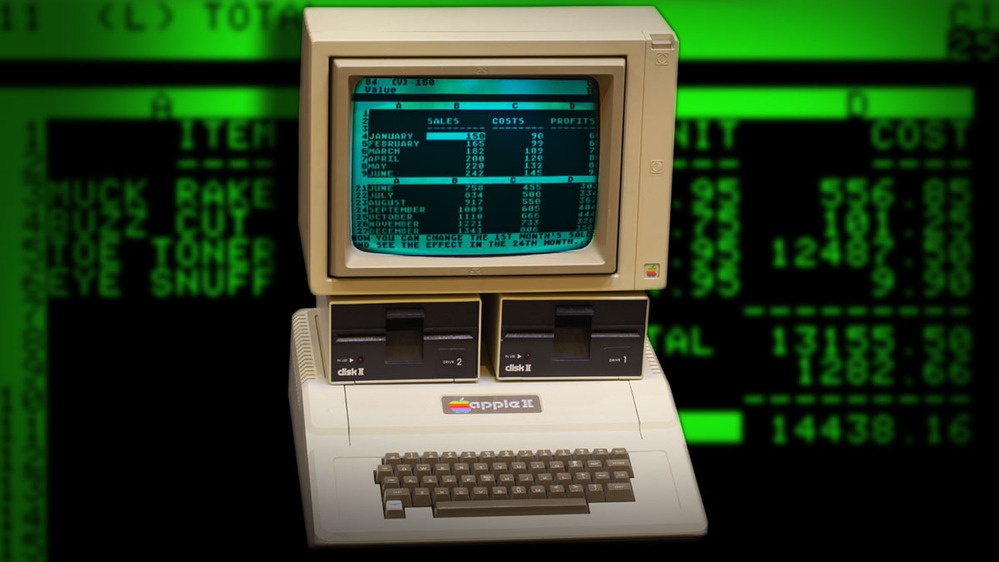
1978
James P. Mitchell created the first LED, flat-screen TV, but it would be decades before it caught on.

1978
The “Laser Disc” is invented! Originally called “Disco Vision”, this predecessor of the CD and DVD was a record-size, analog, optical disc, read by lasers!
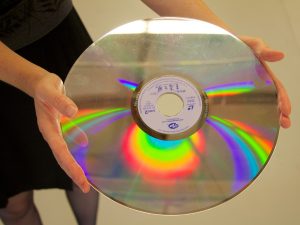
1978
Victor Scheinman, a Stanford graduate, develops the Unimation PUMA robotic arm (Programmable Universal Machine for Assembly, or Programmable Universal Manipulation Arm) for General Motors.

1979
WordStar – the first (successful) word processor.
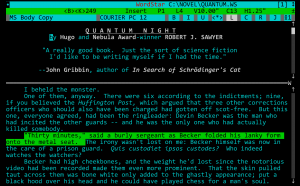
Late 70’s – Early 80’s
The first wave of coin-operated Arcade Games invade: “Space Invaders” (1978), “Pacman” (1980), and “Donkey Kong” (1981). Donkey Kong was created by Shigeru Miyamoto, introducing the world to both Super Mario and Nintendo – at the time it was a simple Japanese card company that was first founded way back in 1889!
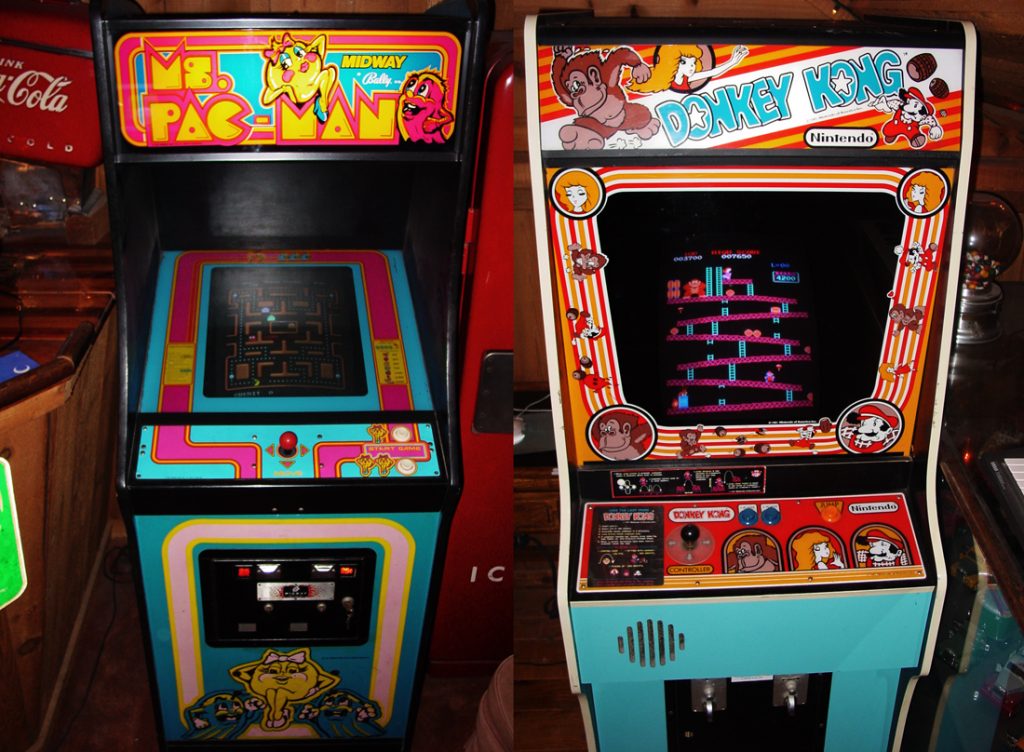
1980
The first Gigabyte Capacity Disk Drive – the IBM 3380! Two rudimentary 1.26 Gig HDD’s. They were housed in a refrigerator-sized cabinet, weighing over a thousand pounds with a price tag of roughly $81,000!

1980: 1 GB?!
1981
IBM presents the “Acorn”, with the MS-DOS operating system from Microsoft.

1981
The First Laptop: The Osborne 1.

1981-1991
Gerd Binnig and Heinrich Rohrer, two IBM scientists, developed the Scanning Tunneling Microscope – heralding the advent of nanotechnology over the next several decades. Don Eigler later led an effort to manipulate 35 atoms of xenon to form the letters: IBMin 1989! This directly led to the development of the first carbon nano-tubes in 1991 by Sumio Iijima.

The alteration of individual atoms at a molecular scale has since proven to be useful for quantum computing systems, and the advancement of “nano-bots” could, one day, potentially help with cutting-edge medicial treatments.
1982-1985
The CD-ROM is first developed by the Japanese company Denon in 1982 and later introduced by Sony in 1985. These ‘Compact Discs’ use lasers to read digital code. Music CD’s replaced both Vinyl Records and Cassette Tapes over night, and computer CD’s proved much more efficient than the archaic Floppy Discs and could hold much more data.

Feel the nostalgia…
1982
John Hopfield invents the Associative Neural Network (ANN): a system of neuron-like units!
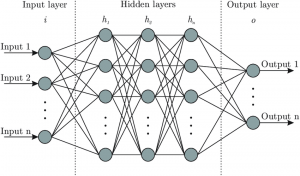
1982
The Japanese government invests in $400 million dollars in the Fifth Generation Computer Project over the next several years. Throughout the 80’s computer technology began to advance at an astounding rate (just as Moore predicted), leading to more and more companies and governments investing in the advancement of computer technologies…

1982
“TRON” a movie about a cybernetic virtual world inhabited by sentient programs, heavily features early computer graphics.

1983-1985
Nintendo launches the 8-bit Famicom home console in Japan. The Famicom was later introduced to North American audiences in 1985 as the NES (the Nintendo Entertainment System) with “Super Mario Bros”! Mario and Donkey Kong’s creator, Miyamoto, went on to create “The Legend of Zelda” in 1986, which was followed up by “Metroid” in 1987 – all franchises that are still huge in the gaming world today!

For more on retro Nintendo games, check out my podcast, “The Super Switch Club”!
1983
The NORAD “War Games” Incident! A full-scale thermonuclear war is narrowly avoided after a computer chip malfunction. (Read more here: 10 Times We Nearly Nuked Ourselves By Accident!)

1984
Fujitsu releases a “touch pad” for the Micro 16 with tiled graphics of Japanese kanji characters.

1984
William Gibson’s “Neuromancer” kickstarts the ‘Cyber Punk’ sci-fi genre!
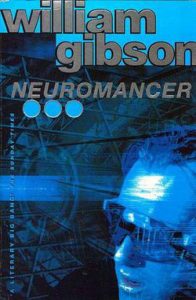
1984
Apple introduces the Macintosh computer, complete with GUI!

1984
“The Terminator” – Directed by James Cameron, Starring Arnold Schwarzenegger.

In this original classic horror / sci-fi blockbuster, a cyborg from the future (the T-800) is sent back in time by an evil sentient AI, “Skynet”, to kill John Connor (the leader of the human resistance in a post-apocalyptic future) before he’s born!
Click here for my Top 25 Time Travel Movies!
1985
David Rumelhart lays the groundwork for the future of AI “Deep Learning” programs with his studies on semantic cognition and simulation models of Neural Networks.

1986
Professor Stephen Hawking, the brilliant cosmologist and theoretical physicist who studied black holes was confined to a wheelchair and had recently lost his voice due to complications with ALS (aka Lou Gehrig’s disease), but breakthroughs in text-to-speech technology gave the Professor his ‘voice’ back thanks to the “Equalizer” software – developed by Walter Woltosz using a Speech Plus CallText 5010 synthesizer built into his chair! Hawking’s iconic computer voice was based on the MIT researcher, Dennis Klatt, whose voice was also used for DECtalk systems.

In 1997, Intel offered to upgrade Professor Hawking’s chair with the ACAT system (Assistive Context-Aware Toolkit), and continued to enhance it until his demise in 2018. The original system used a clicker, which was later replaced with infrared sensors in his glasses that detected facial movements after he lost all motor function in his thumbs. Without these communication tools, the world would have missed out on the gift of his genius.
1987
The Apple Mac II makes its debut!

1987
Photoshop is first developed by Thomas Knoll and his brother, John Knoll. Later sold to Adobe Systems Inc.

1987
“Star Trek: The Next Generation” premiers! One of the main crewmembers of the USS Enterprise NCC-1701-D is Lt. Commander Data – a sentient android who aspires to become more human and goes on a spiritual journey of discovery throughout both the show and the movies that follow, with key episodes like “Measure of a Man” (TNG – S2, E9). TNG also introduces The Borg – a nefarious cybernetic collective hive-mind bent on assimilating the galaxy… (See TNG – S3, E26: “The Best of Both Worlds”)

The 24th Century series regularly features data-pads (seemingly predicting modern-day tablets), touch-screen controls (back when that was a far out concept), Replicators (extremely high-tech versions of modern-day 3D printers), Holo-Decks (back when true virtual reality was decades away), language translators, database search engines, and highly advanced computer systems that people can casually talk to, way before any of that was possible!
Click here for my summary of Every Star Trek Series Ever – So Far!
1988
The Morris Worm: The First Computer Virus! (click here for 15 of the Most Infamous Cyber Heists!)

1989
James Cameron’s “The Abyss” features the first fully computer-generated character in a motion picture, thanks to the CGI (Computer Graphic Imagery) wizards from George Lucas’s special effects think tank – ILM: Industrial Light and Magic!

1989
Nintendo introduces the GameBoy, (one of the first of many handheld video game consoles) packaged with “Tetris” – the insanely addictive Russian puzzle game – in all it’s black and white (err, black and green?) glory!

1989
Crystal River Engineering Inc develops a VR simulator to train astronauts for NASA –the Virtual Environment Workstation Project! (Codename: VIEW)

This early virtual reality headset featured stereoscopic goggles and real-time binaural 3D audio – all controlled by Data-Gloves designed by VPL Research (Virtual Programming Languages)!
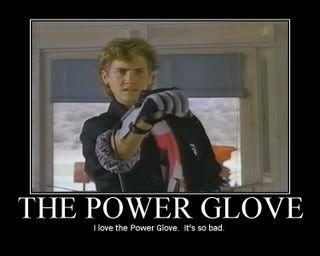
1989
British researcher, Sir Tim Berners-Lee creates a proposal for the World Wide Web and invents HTML (Hyper-Text-Markup-Language), while at CERN, using a NeXT work station computer as the very first web server! Originally dubbed as “The Information Super Highway”, Berners-Lee basically made The Internet, as we know it today, possible! And was later knighted as a result of this groundbreaking achievement!

Just like the early trans-continental telegraph lines, the internet is primarily connected through massive under-water fiber-optics cables that crisscross the ocean floor, connecting the world like never before with near-instantaneous speeds! (Well, if you have a good connection that is…)
Late 1980’s, Early 1990’s
Although it didn’t fully catch on until the early 2000’s, the technology behind DSL for high-speed internet (using cable instead of phone lines) was first developed by Bell Laboratories in the late 1980’s, but didn’t hit the public market until the early 1990’s in very limited sectors, and didn’t become the norm until the early 2000’s…
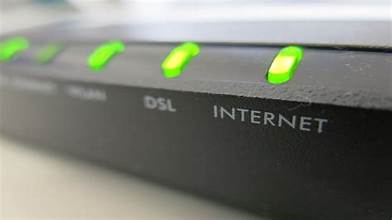
1991

<Dial-up sounds> “You’ve got mail!”
AOL (America On-Line) Dial-Up Internet makes its way into homes across the US for the first time.
For anyone who wasn’t around at the time, it’s hard to explain exactly what it was like before the internet was commonplace (well before smart phones for that matter). Back in the ancient past (the early 90’s), when we had to use paper maps for directions, had to actually call to order pizza, or check movie times, and had to drive to the library to look up random facts. And even as it started to catch on, the internet of the early 90’s was a far different landscape than it is today. Long before social media was even a concept, well before You Tube videos, gifs, and memes, and before the ‘dot com’ bubble burst. The ‘Wild West’ days of message boards, and chat rooms, when the idea of connecting with others across the globe was new and exciting…

Only 90s kids will remember…
Side note: The first AOL “Instant Message” was in 1993, sent from Ted Leonsis to his wife: “Don’t be scared… it is me. Love you and miss you.”
1991
Apple introduces the PowerBook laptop!

1991
“Terminator 2: Judgement Day” – Directed by James Cameron, Starring Arnold Schwarzenegger.
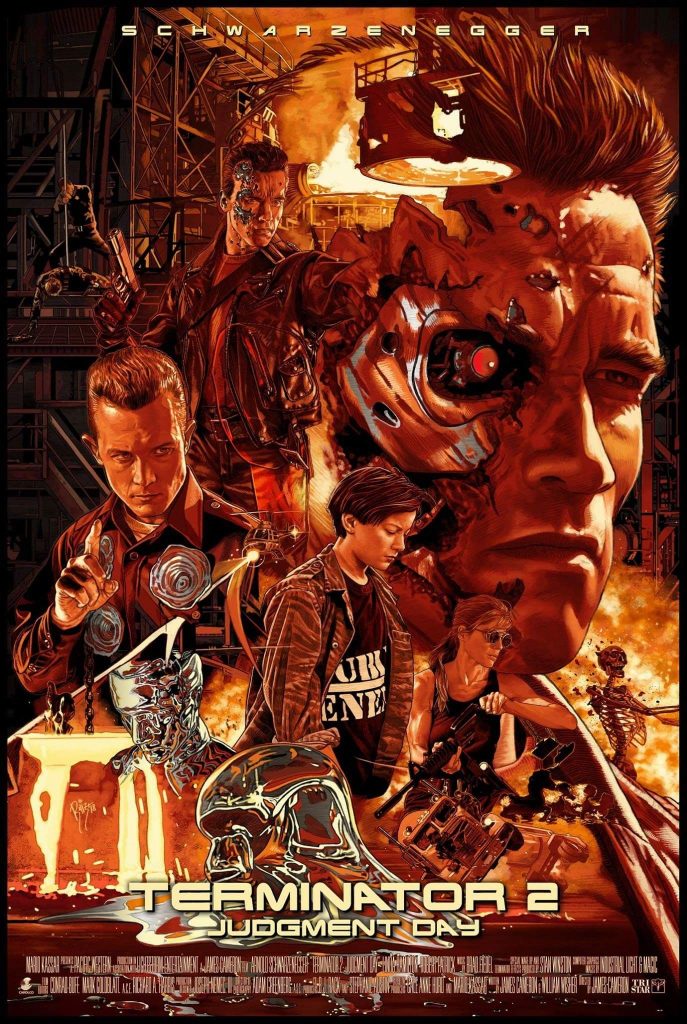
Another T-800 is sent back in time, this time reprogrammed to protect a young John Connor from a shape-shifting, liquid metal AI: The T-1000! While John and his mother attempt to stop Cyberdyne Systems from developing Skynet in the first place, the Terminator begins to develop feelings and sacrifices itself to save the future…

1991-1994
The Console Wars begin between Nintendo and Sega…

The Sega first introduced the 16-bit Sega Master System in 1986 (later rebranded as the Sega Genesis, with the introduction of “Sonic the Hedgehog”) to compete with the NES, but in 1991, their rival introduced its own 16-bit console: The Super Nintendo (SNES)!

1992
The first digital photo is uploaded online by Tim Berners-Lee:

A promotional shot of an indie comedy band of four female CERN scientists, “Les Horribles Cernettes”. Images like this would often take up to a minute or more to load on dial-up internet speeds! (Worth keeping in mind next time you’re frustrated with a couple seconds of lag on broadband!)
1992-2001
The Evolution of 3D Gaming…

After first invading arcades with games like “Mortal Kombat” (one of the earliest games with photo-realistic digitized sprites) and “Virtua Fighter” (one of the earliest 3D polygon fighting games), in 1992, PC gamers first got their hands on the first First-Person-Shooter (FPS) – “Wolfenstein 3D”, which was then surpassed by 1993’s “DOOM!”, as well as both “Quake” and “Duke Nukem 3D” in 1996.
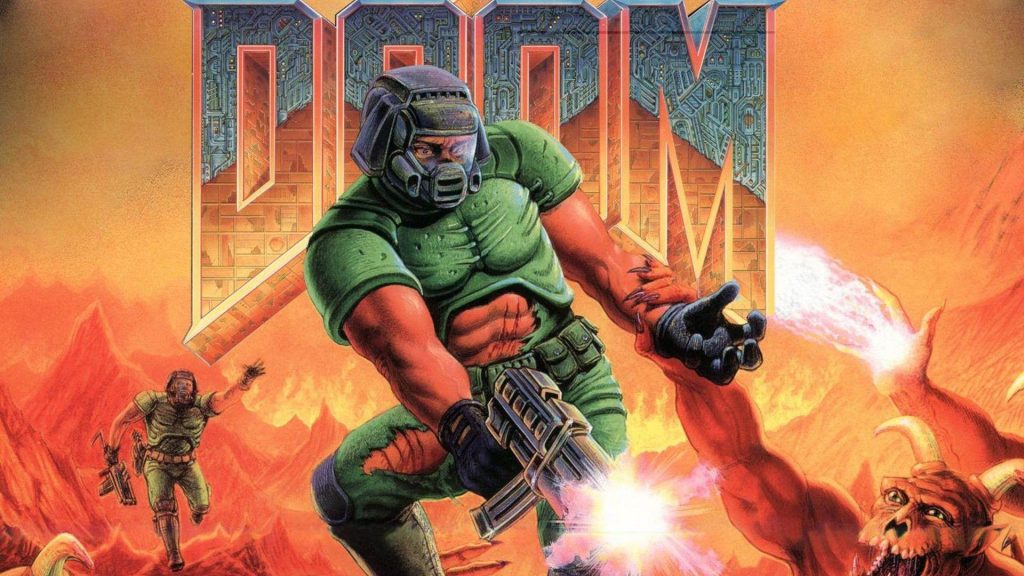
Meanwhile, the 32-bit Sony Playstation premiered in 1994, followed soon after by the Nintendo 64 in 1996 – a 64-bit system, with up to 4 players (N64 games included: “The Legend of Zelda: Ocarina of Time”, “Mario Kart 64”, “Star Fox 64”, “Super Smash Bros”, “Goldeneye”, and “Banjo-Kazooie”), and Microsoft’s X-Box in 2001 – which pushed online gaming forward with games like “Halo”!

1993
The Intel Pentium Microprocessor CPU.

1993
Steven Spielberg’s “Jurassic Park” (based on the novel by Michael Crichton) utilizes some of the most convincing CGI in a movie to date, thanks to ILM, forever changing the Hollywood blockbuster. Because of the balanced mix between practical effects, animatronics, and superb CG (used sparingly), the movie visually holds up spectacularly well compared to so many movies that came after…

The storyline itself is about the hubris of man and systems of control succumbing to chaos theory – which could be seen as yet another allegory for what could go wrong with the creation of AI if we’re not careful…
1993
The first movie live-streamed on the internet: a bizarre, anti-war, indie film titled, “Wax or the Discovery of Television Among the Bees” at an astounding 2 frames per second! (24-frames-per-second is the standard lol)

Quick-Time Videos became the norm by the mid-90’s for downloading videos, but even a movie trailer could take a full day to download on a standard dial-up-internet connection! (Trust me, I was there!) One of the early internet “fan-films” to really go ‘viral’ was the Star Wars / Cops parody, “Troops” in 1997 – which jump-started the modern day fan-film trend! (Worth pointing out to you Gen-Z ‘kids’ out there: You-Tube itself wasn’t created until 2005 – launching with its first video: “Me at the Zoo”!)
1994
Amazon.com is founded by Jeff Bezos, originally primarily a used book seller.

1994
The first Drone / UAV (Unmanned-Aerial-Vehicle) – first developed for the CIA to spy on foreign adversaries, the United States Air Force implements the first military “Predator Drone”! (Read more here: 25 Epic Aviation Milestones!)

1995
Pixar’s “Toy Story” – Directed by John Lasseter – the first fully CGI animated movie! (Just a few years earlier, in 1990, Steve Jobs purchased Pixar Studios from ILM, who then made a distribution deal with Disney.)

1995
Microsoft debuts Windows 95…

(Seriously, am I the only one that has nostalgia for this era?)
1996
The DVD (Digital Video Disc) is introduced, slowly replacing VHS over the next several years.

The far-superior Blu-Ray discs came on to the scene in 2006 – along with HDMI cables, and High-Definition LED plasma screen TV’s effectively replacing the old cathode-ray TV sets of the 20th century.
1996
The first Flip Phone! (Motorola’s StarTAC) Inspired by the sleek, portable communicator that Captain Kirk used on Star Trek in the 60’s!

The first ‘Camera Phone’ didn’t come out till 1999.
1996
ZEUS – the first Robotic Surgery System!

The da Vinci Surgical System was first implemented just a few years later in 2000…
1996
Sergey Brin and Larry Page develop Google at Stanford University, destined to be the one search engine to rule them all…

Over the next several years, after such humble beginnings, back when ‘Yahoo!’ was a serious competitor, Google quickly became one of the most valuable companies in the world, and by 2023 was worth $1.37 Trillion! (Take that “Ask Jeeves”! )
1997
The IBM Deskstar (16GB) “Titan” – 16,800 megabytes and the first Giant Magnetoresistance heads (GMR).

1997: 16GB
At the time, a Gig was still considered A LOT, but as of 2020 you can get a whole Terra-byte on a penny-sized flash drive!
1997
IBM’s “Deep Blue” computer defeats world chess champion, Garry Kasparov in a tournament!

1997
Dragon Systems developed the world’s first Speech Recognition Software for Windows.

1997
Wi-Fi (Wireless Fidelity) enters the modern home, paving the way for smart devices!

Although both Nikola Tesla and Hedy Lamarr had experimented with wireless technology generations earlier, it wasn’t introduced to the public until the late 90’s, but it wouldn’t become an integral part of our modern lives for another several years. Today, it seems like nearly everything is connected on Wi-Fi networks!
1997
NASA’s Mars Pathfinder mission, sends the first robotic Mars Rover to the red planet: Sojourner!

Sojourner was followed by Spirit and Opportunity in 2004, Curiosity in 2012, and Perseverance in 2021 – which came with a high-tech helicopter drone called Ingenuity!
1998
The first USB Flash Drive is developed by Intel, IBM, and Microsoft.

1998: 8 MB
1998
Apple releases the iMac G3 – one of the best-selling PC’s of all time, with 6.5 million units sold!

A classroom staple of the early 2000’s
1998
Isaac Chuang (of the Los Alamos National Laboratory), Neil Gershenfeld (from MIT), and Mark Kubinec (Berkeley) create the first Quantum Computer, with just 2 Qubits – proving the potential viability of Quantum Computing!

1999
Napster launches – a controversial music sharing platform where millions of people shared music through MP3 files – changing both the music industry and inadvertently laying the groundwork for streaming media, which is now commonplace.

1999
The first Robo-Dog: Sony’s AIBO (ERS-110)

1999
“The Matrix” – Directed by the Wachowskis, Starring Keanu Reeves.
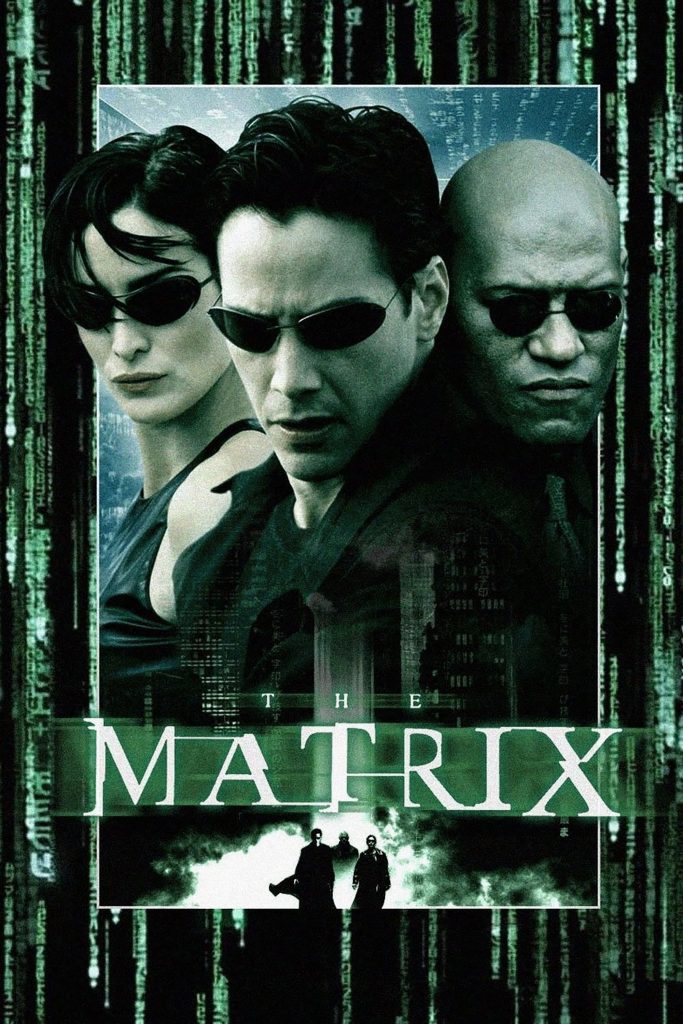
A mind-bending action movie about humanity being trapped in a virtual reality simulation run by sentient AI…
Click here for my full review of the movie on Podcasters Assemble!
1999
Y2k… doesn’t happen. (Click here for more on all that!)

2000
Honda introduces ASIMO (Advanced Step-in Innovative Mobility) – a highly advanced humanoid robot that could navigate its environment autonomously, and had the ability to recognize moving objects, faces, sounds, and could even interact with people!
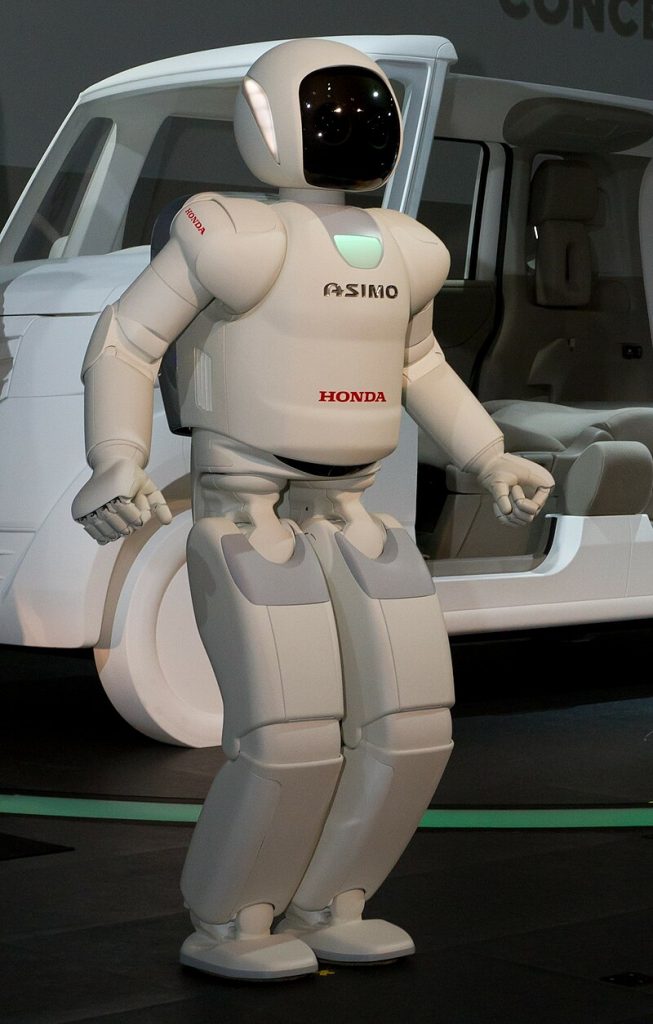
Suffice it to say, computers and robotics had come A LONG way since Elektro and the Z3 in the late 1930’s, but at the turn of the millennium, things were just getting started.
To be continued…
ERIK SLADER
Next Time in Part 3: Advanced Robotics, Quantum Computing, and the Rise of Artificial Intelligence!
For more on the History and Future of A.I. – listen to Episode 33 of the Epik Fails of History podcast! (click here to check out some A.I. History Art we made for the episode!) Also, be sure to check out my other articles: 10 Accidental Inventions and Discoveries (Part 1 of 2), 15 Early (Failed) Attempts at Flight – Before the Wright Brothers, and 15 of the Most Infamous Cyber Heists!



